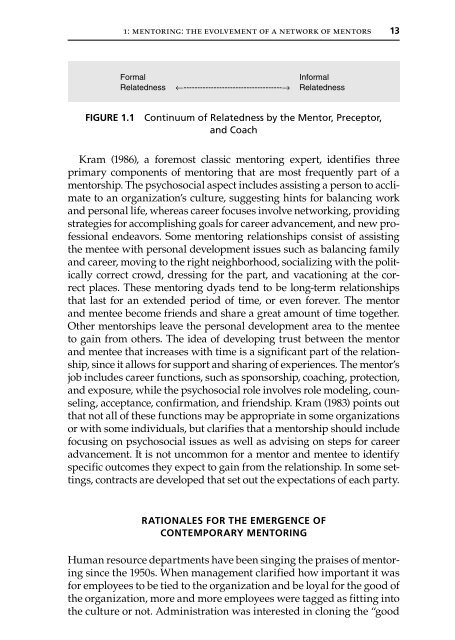Mentoring in Nursing - Springer Publishing
Mentoring in Nursing - Springer Publishing
Mentoring in Nursing - Springer Publishing
Create successful ePaper yourself
Turn your PDF publications into a flip-book with our unique Google optimized e-Paper software.
1: mentor<strong>in</strong>g: the evolvement of a network of mentors 13<br />
Formal<br />
Relatedness<br />
←------------------------------------→<br />
Informal<br />
Relatedness<br />
FIGURE 1.1 Cont<strong>in</strong>uum of Relatedness by the Mentor, Preceptor,<br />
and Coach<br />
Kram (1986), a foremost classic mentor<strong>in</strong>g expert, identifies three<br />
primary components of mentor<strong>in</strong>g that are most frequently part of a<br />
mentorship. The psychosocial aspect <strong>in</strong>cludes assist<strong>in</strong>g a person to acclimate<br />
to an organization’s culture, suggest<strong>in</strong>g h<strong>in</strong>ts for balanc<strong>in</strong>g work<br />
and personal life, whereas career focuses <strong>in</strong>volve network<strong>in</strong>g, provid<strong>in</strong>g<br />
strategies for accomplish<strong>in</strong>g goals for career advancement, and new professional<br />
endeavors. Some mentor<strong>in</strong>g relationships consist of assist<strong>in</strong>g<br />
the mentee with personal development issues such as balanc<strong>in</strong>g family<br />
and career, mov<strong>in</strong>g to the right neighborhood, socializ<strong>in</strong>g with the politically<br />
correct crowd, dress<strong>in</strong>g for the part, and vacation<strong>in</strong>g at the correct<br />
places. These mentor<strong>in</strong>g dyads tend to be long-term relationships<br />
that last for an extended period of time, or even forever. The mentor<br />
and mentee become friends and share a great amount of time together.<br />
Other mentorships leave the personal development area to the mentee<br />
to ga<strong>in</strong> from others. The idea of develop<strong>in</strong>g trust between the mentor<br />
and mentee that <strong>in</strong>creases with time is a significant part of the relationship,<br />
s<strong>in</strong>ce it allows for support and shar<strong>in</strong>g of experiences. The mentor’s<br />
job <strong>in</strong>cludes career functions, such as sponsorship, coach<strong>in</strong>g, protection,<br />
and exposure, while the psychosocial role <strong>in</strong>volves role model<strong>in</strong>g, counsel<strong>in</strong>g,<br />
acceptance, confirmation, and friendship. Kram (1983) po<strong>in</strong>ts out<br />
that not all of these functions may be appropriate <strong>in</strong> some organizations<br />
or with some <strong>in</strong>dividuals, but clarifies that a mentorship should <strong>in</strong>clude<br />
focus<strong>in</strong>g on psychosocial issues as well as advis<strong>in</strong>g on steps for career<br />
advancement. It is not uncommon for a mentor and mentee to identify<br />
specific outcomes they expect to ga<strong>in</strong> from the relationship. In some sett<strong>in</strong>gs,<br />
contracts are developed that set out the expectations of each party.<br />
RATIONALES FOR THE EMERGENCE OF<br />
CONTEMPORARY MENTORING<br />
Human resource departments have been s<strong>in</strong>g<strong>in</strong>g the praises of mentor<strong>in</strong>g<br />
s<strong>in</strong>ce the 1950s. When management clarified how important it was<br />
for employees to be tied to the organization and be loyal for the good of<br />
the organization, more and more employees were tagged as fitt<strong>in</strong>g <strong>in</strong>to<br />
the culture or not. Adm<strong>in</strong>istration was <strong>in</strong>terested <strong>in</strong> clon<strong>in</strong>g the “good
















